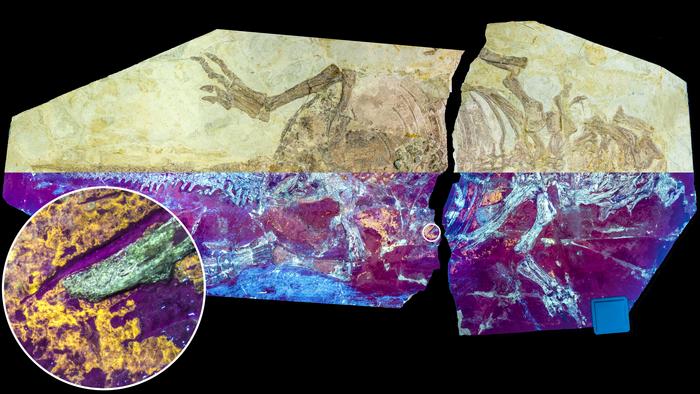Some Dinosaurs Sported Scales and Feathers as an Evolutionary Advantage
Posted on Categories Discover Magazine

The question of whether some dinosaurs were covered with either scales or feathers has a new answer: both.
Researchers examined the skin of the feathered dinosaur Psittacosaurus from the early Cretaceous period (135 million years to 120 million years ago) and found “zones” of reptile-style scales as well as “zones” where feathers were present, according to a study in Nature Communications. The early Cretaceous marks the period when some dinosaurs were evolving into birds.
Rare Skin Sample
The finding was as unusual as the conditions that prompted it: the skin tissue was preserved in an unusual way that made it more receptive to imaging technology. The team who unearthed the Psittacosaurus specimen in China were initially unaware that skin cells were present.
“The fossil truly is a hidden gem,” Zixiao Yang, a paleontologist at the University of Cork in Ireland who led the research team, said in a press release. “The fossil skin is not visible to the naked eye, and it remained hidden when the specimen was donated to Nanjing University in 2021. Only under UV light is the skin visible, in a striking orange-yellow glow.”
Yang worked with Maria McNamara of UCC’s School of Biological, Earth and Environmental Sciences, and scientists based in Nanjing University, China, to investigate the dinosaur skin. The team first used ultraviolet (UV) light to identify patches of preserved skin. Once they identified skin patches, the team turned to X-rays and infrared light to expose details of preserved cellular structures.
The findings help explain how some dinosaur species transitioned from reptiles to more bird-like creatures, McNamara, said in a press release.
“The evolution of feathers from reptilian scales is one of the most profound yet poorly understood events in vertebrate evolution,” McNamara said. “While numerous fossils of feathers have been studied, fossil skin is much more rare.”
Read More: Did All Dinosaurs Have Feathers?
Dinosaur Evolutionary Advantage
Soft skin supporting feathers combined with other areas covered by scales probably provided an evolutionary advantage.
“This zoned development would have maintained essential skin functions, such as protection against abrasion, dehydration and parasites,” McNamara said. “The first dinosaur to experiment with feathers could therefore survive and pass down the genes for feathers to their offspring.”
Those imaging techniques revealed another surprise — this time about the Psittacosaurus skin’s chemistry.
“It is composed of silica – the same as glass. This type of preservation has never been found in vertebrate fossils,” said Yang. “There are potentially many more fossils with hidden soft tissues awaiting discovery.”
Read More: A Complete Dinosaur Timeline to Extinction: How Long Did They Roam Earth?
Article Sources
Our writers at Discovermagazine.com use peer-reviewed studies and high-quality sources for our articles, and our editors review for scientific accuracy and editorial standards. Review the sources used below for this article:
Before joining Discover Magazine, Paul spent over 20 years as a science journalist, specializing in U.S. life science policy and global scientific career issues. He began his career in newspapers, but switched to scientific magazines. His work has appeared in publications including Science News, Science, Nature, and Scientific American.